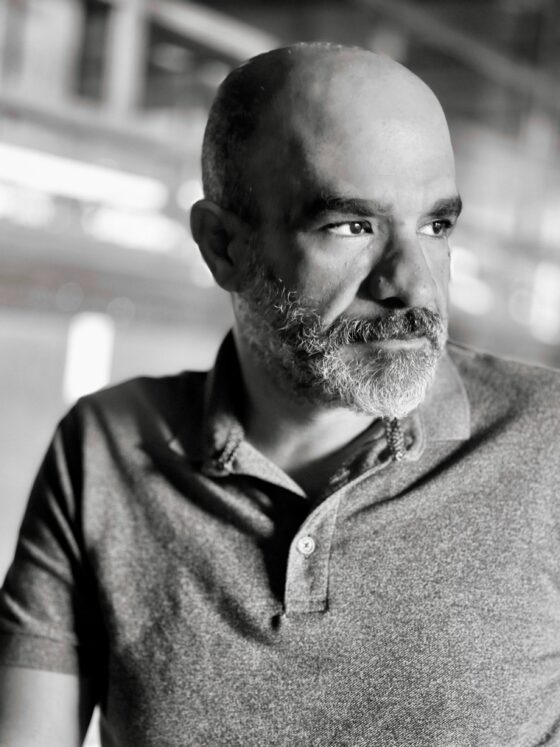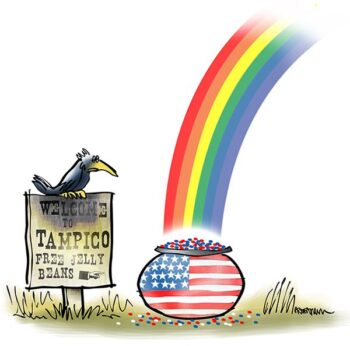
“All of a sudden this plane came out of the clouds from the east, it came down very, very low, it tipped its wings, and then it flew on into another cloud bank in the west. It was the most thrilling thing that any of us had ever seen.”
—Joan Johnson, President, Tampico Historical Society
***
Heavy rain fell on Tampico, Illinois, on November 3, 1980, and by late afternoon, when it cleared up, a majestic double rainbow materialized in the sky above the quiet prairie village. Lloyd McElhiney, manager of the Tampico grain elevator, noticed it first—how it swooped from the clouds onto Main Street’s single-block stretch, and how its luminous arc seemed to point, decisively, to the walkup apartment where Ronald Reagan was born. So he darted home for a camera, just fast enough to capture the scene on grainy Polaroid.[1]
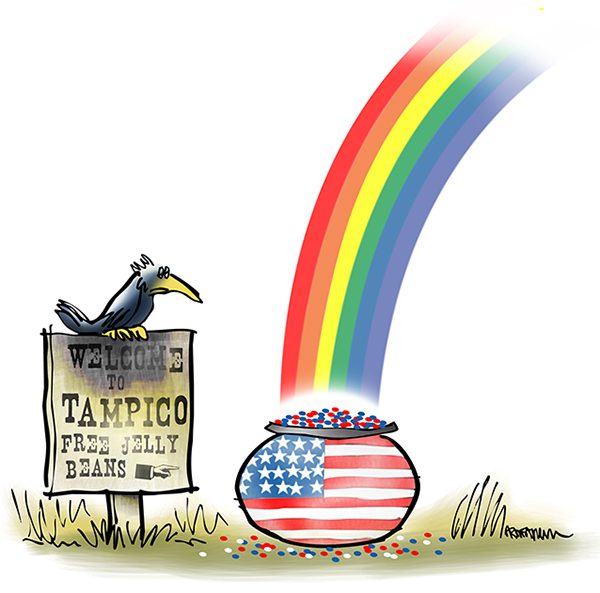 The next day, Reagan was elected president by a landslide, the most decisive non-incumbent upset since 1932.
The next day, Reagan was elected president by a landslide, the most decisive non-incumbent upset since 1932.
The election spelled triumph for conservative intellectual circles, still reeling from the trauma of Goldwater’s defeat in 1964. It signaled victory for the Religious Right, freshly mobilized by the emergence of the Moral Majority in 1979. It restored prestige to a GOP that had been wounded by Watergate’s lingering disgrace.
And it brought a rich tumult of unnamable emotion to Tampico, Illinois, where locals recall watching Reagan’s victory speech on TV that night and tearing up when he spoke the name of their town. “That guy,” muttered an older gentleman at the time, a lifelong Democrat, “he’s just one of us.”[2]
Someone mailed the photo of the Reagan Rainbow to the president-elect, who pasted the copy into a personal scrapbook and kept it in an Oval Office desk drawer for eight years. As townspeople tell it, he would turn to the image for inspiration. To their delight, he mentioned it in his memoir.
“Ronald called the postcard eerie,” says Amy McElhiney, the photographer’s widow, who led visitors through the birthplace for twelve years before growing too frail. “We like to call it prophetic.”
Tampico is like a thousand other Midwestern prairie towns. But Tampico is like no other Midwestern prairie town. The village lies about 115 miles west of Chicago, closer to the Iowa border, in the vast cornfield flats of northwestern Illinois. Its industry remains chiefly agricultural in nature, its historic Main Street only a single-block stretch. There is a diner, a park, a funeral home, the birthplace, two churches, all tightly packed redbrick structures with vertical windows and awnings lining the brief expanse. At the end of the block sits the Tampico Farmers’ Elevator from which Lloyd saw the rainbow, a cluster of white domelike structures offering themselves up into the Midwestern sky.
There’s no law firm, no bookstore, no sleek visitor center or river for the farms in town. Hold McElhiney’s photo up against Main Street—you’ll spot where the rainbow sloped down to Reaganville, USA. In a town of 790 people, what else is there to see?
Ronald Reagan was born on the second level of the Graham Building at 111 South Main Street, a cramped walkup apartment above what still proclaims itself to be the FIRST NATIONAL BANK. “He looks like a fat little Dutchman,” his father was said to have remarked on first glancing the newborn, “but who knows, he might grow up to be president some day.”
Built in 1895, the building was home to the Reagan family from 1906 to 1911, when they moved into a house nearby just a few months after the future president was born. Below the apartment then was a saloon, though Tampico claims it was a bakery (it became one in 1915) for the sake of respectability.
There are three bedrooms in the apartment above the museum, and they are cramped and musty, airless in summer, with yellowing Reagan family photos ornamenting the shriveled flower wallpaper. There is a tight kitchen, a long hallway containing an ironing board and a birdcage, and a modest collection of vintage furniture all amassed by the curator during the Reagan presidency. To the right is the especially stuffy bedroom where Ronald Wilson Reagan was born—a small bed in the corner and a window on the right opening into the adjacent apartment. Jack and Nelle Reagan were close with the couple who lived next door. Often, for convenience, they would babysit each other’s children, and instead of climbing up and down the impossibly narrow staircase, they would hand off Baby Ronald like a football back and forth through the window.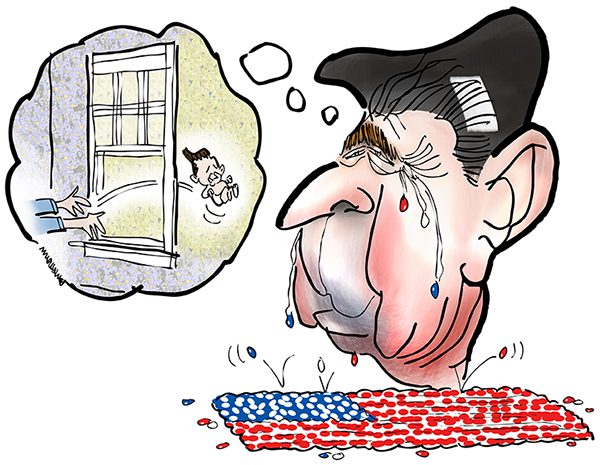
“When [Reagan] visited us in 1992, he went through the Reagan Window as an adult,” a guide tells me. “And both his sons, Michael and Ronald, were here last year, and they got to climb through the window as well. And Newt Gingrich has gone through it. And Ed Meese.”
When Reagan first ran for president in 1976, one Paul Nicely still rented out the apartment. By then, Nicely, a one-armed Tampico native and retired schoolteacher with a particular reverence for the president’s mother, had converted the bank level downstairs into a small memorabilia shop. After the 1980 win, he spent his life savings collecting artifacts, restoring the apartment to its 1911 appearance, and opening it as a locally run museum.
Nicely died of a heart attack in 1994, and his wife soon succumbed to dementia, so the McElhineys—Lloyd, the photographer, and his wife Amy—took over, shepherding visitors through the museum on a volunteer basis, canes in hand, and organizing annual birthday bashes for Ronnie. When Lloyd died in 2006, Amy pooled all of his memorial donations for a bronze Reagan boyhood statue in the children’s park. There wasn’t enough money for the statue, and she was too frail to continue alone with the tours.
Today the birthplace is managed by Joan Johnson, the sprightly, white-haired president of the Tampico Historical Society. She comes armed with postcards, brochures, and complimentary jellybeans—the president’s favorite snack. Her uniform: faded black shorts and an oversized, messily tucked “Reagan’s Rainbow” t-shirt.
Joan tells me about the Reagan Window, about the annual Reagan-themed parade. In fact, Tampico receives visitors from all over the world. Once, there was a bus of sixteen farmers from Bulgaria, eager to pay their thanks to Reagan for fighting the Soviet Union.
“It’s a pleasant place for people to come,” says Joan. “But we really don’t have industry or anything anymore.” She shrugs. “We do have a doctor. And that’s a big plus.”
Her pet peeve: people who claim the president was born in Dixon, IL—30 miles northeast of here, where he spent much of his boyhood.
“No, he was actually born here,” Joan retorts, indignant, pointing at the ground. “This is where the story started.”
And this is where Reagan returned, three times in 42 years, as an adult, first, in 1950, as his acting career wrapped up. He served as grand marshal of the 1950 cheese festival. Shortly after, the town creamery shut down, and that was the end of that.
Then, in 1976, during his first bid for the Republican nomination, he spent a day campaigning in Tampico. Joan recalls seeing him speak at the local school. Grudgingly, Nancy accompanied him. Her husband wanted to see the room where he was born, but there were still tenants occupying the apartment, which was not yet a museum, and security detail vetoed the plan.
He never visited as sitting president. When he came as close as Dixon for a birthday reception in 1984, locals were peeved. “Before he left, he said he’d be back,” griped Mr. Nicely, who had spent thousands of dollars since Reagan’s 1976 visit restoring the birthplace, “but he’s never been back.”[3]
Finally, in 1992, the president expressed an inexplicable desire to return home. His presidency was over. His Alzheimer’s diagnosis two years away, but the signs—fleeting memory lapses, sudden pauses in speech—were firmly there. They were there, some say, as the second term ended.
Stumbling, lost, did the aging president remember his roots? Never known for his memory, Reagan had always favored witticisms, stories, over facts and detail. So Edmund Morris, his biographer, escorted him and Nancy on the trip. An unmarked black rental car shuttled the party from a Rock Falls airport to the Tampico Church of Christ. “We belong to the Methodist church in Tampico, and halfway through the service, someone came running in crying, ‘He’s here, he’s here!’” Joan recalls.
After the service, the Reagan party made its way to 111 South Main. “You don’t have to pretend to remember this place,” Morris assured the Dutch. “You were only three months old when your parents checked out.”[4]
“Yes,” said Reagan, confusing his birthplace with the residence his family occupied eight years later, “we went to live over the store where my father worked.”
By 1992, the Reagan Birthplace was a teeming, ridiculous shrine of a museum. I imagine the 81-year-old president eying the homespun, hand-painted signpost out front: “PRES. REAGAN BIRTHPLACE,” it reads in red, white, and blue block lettering, peeling cheaply below a plain “OPEN” banner. “Ronald Reagan ‘Stept’ Here,” proclaims the doormat inside.
He enters: a dizzying array of memorabilia, artifacts, and Reagan-themed miscellanea. The material bric-a-brac of political life, from the curiousto the useless and everything in between—old letters, report cards, movie posters, model photos, presidential seals, portraits, news clippings, postcards, fan mail, stamps, bobble heads, caricatures, Ronald-and-Nancy coloring books, jellybeans, a “World’s Best President” certificate that appears to belong in a third-grade classroom in northwestern Illinois. The novelty pours out from the walls, from the desk drawers, from the welcoming hands of the sweet old ladies who hand you jellybeans before you sneak out to the road. These are memories, packaged, dusted, shrink-wrapped, and worn. How strange are they for the man to whom they belonged?
So they take him upstairs, spin him around to the darkly lit bed where he began, and—
“This, Mr. President,” says Mrs. Nicely, “is where you were born.”
Cold silence. He sucks in his breath.
“He wheeled his big body, faced away from the past, and began to tell jokes,” Morris writes. “The bed had shocked him into temporary lucidity.”
Reagan’s memory was fading, or had it been anchored, dreamlike and bent, onto some other figure?
Two doors down from the birthplace is the Dutch Diner, and when I enter for lunch, there sits an animated group of six or seven locals, apparent old-timers, in discussion at a round table. Their argument revolves around how to improve the street sign proclaiming the birthplace. I’m distracted by the graying Reagan movie posters glaring from the walls—Hell’s Kitchen, Night Into Night.
I work up the nerve to approach the table. They seem thrilled to have a new listener, and somehow the subject turns to the week after Reagan’s death.
“They were in town interviewing people, and the whole week after he died, they had so much equipment in the birthplace that you had to walk around cords and big lights and everything!” a boisterous woman, about 60 or 65, raves. “Amy and Lloyd were so busy with people visiting that they didn’t even have time to eat lunch. And there were all kinds of people outside, inside, everywhere—and you had all kinds of radio stations, TVs, everything was here!”
When the plane carrying the president’s body flew over Illinois en route to California, Tampico received word that it would pass over at 3:07 p.m. The woman talks faster, her eyes wild.
“When they came, the WGN had their camera up there and as they flew over the town, they tipped their wing. And that was kind of exciting—they were saying, ‘Look at all the corn below!’ and we were saying, ‘Oh my gosh, there goes Ronald Reagan’s body, isn’t that exciting?’”
I think of Lloyd McElhiney with his Polaroid, peering up at the Illinois sky.
“Well, that was the first time Ronald Reagan’s body ever flew over Tampico,” a man across the table interjects, and at once they roar.
I’m reminded of another conversation entirely. A few weeks before visiting Tampico, I got in touch with George Cleveland, a boisterous grandson of Grover Cleveland, and his wife, Frances Folsom. The 58-year-old heir runs a senior service center by day but trots his grandfather’s stomping grounds in his spare time, impersonating the president as “warm-up entertainment” at local events.[5] I emailed him (I was just back from Grover’s birthplace in Caldwell, NJ), and he dashed off a quick reply in bright purple Georgia typeface:
If you can, give me a call before 10 this evening. Tomorrow is going to be wild and life gets perkier after that.
So I did, and if I expected a dry explication of a 179-year-old manse, I received instead a colorful 45-minute ramble on the life and times of a presidential descendant—on fighting off biographers who insist his grandfather was a “big rapist child-eating monster,” on shocking Buffalo townspeople with his family resemblance, and on being related to the “first lesbian First Lady.”[6] But what he really wanted to tell me about was the Marshfield Cherry Blossom Festival and Presidential Family Reunion, an annual gathering of the bizarre in Marshfield, MO, “the only place on earth you’ll get Elly May Clampett from Beverly Hillbillies and George McGovern in the same room.”
“It’s kind of like all reality is suspended for about five days,” Cleveland continued, hoarse and frenzied over speakerphone. “I met one of the original munchkins, and I almost got him to run for president in the New Hampshire primary.” That was the same day he watched descendants of Jefferson Davis and Dred Scott warmly embrace.
And then: “It’s beyond Americana! A world all unto itself.”
It’s what? It’s where?
Cleveland’s words lingered. When I pulled into Tampico’s storybook Main Street a month later, they fell strangely into place.
“THIS IS REAGAN COUNTRY,” offers a wizened sign atop the roof of the town convenience store. This is Reagan’s country. Yes, but this is Reagan Country. It’s not political, not a GOP slogan. Nothing to do with tax reform, Grenada, supply-side economics. It’s a beckoning, a greeting—a suspension of reality. A 0.4-square-mile fantasy, or a national subconscious.
There is a space that lies beyond Americana, that exists outside—apart from—the borderlines of memory and narrative and withered material artifact, where history tangles toward mythmaking until their threads seamlessly intertwine. It is a place where double-curved rainbows signal divine purpose, where saloons are bakeries and birthplaces nostalgia shops, where babies are born fat little Dutchmen, but who knows, they could grow up to be president, and tell stories, and forget.
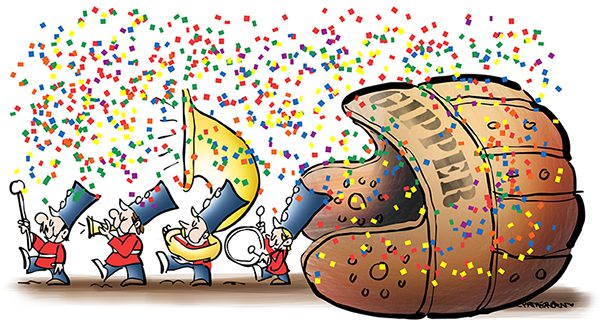 Ronald Reagan never regarded himself as a career politician. When he entered politics at the seasoned age of fifty-five, he did so as an ordinary citizen called into office with certain core principles and convictions about how government ought to work. So why have we elevated the Gipper beyond personhood and into the realm of figment and myth? Where do man and memory collide, and who decides?
Ronald Reagan never regarded himself as a career politician. When he entered politics at the seasoned age of fifty-five, he did so as an ordinary citizen called into office with certain core principles and convictions about how government ought to work. So why have we elevated the Gipper beyond personhood and into the realm of figment and myth? Where do man and memory collide, and who decides?
Fogged by history, swamped in contradiction, Reagan’s is an unusual legacy. Certainly no other president since Kennedy begs the same shimmering reverence as the Gipper.[7] On paper, it’s simple. Reagan matches just the criteria for an American presidential mythmaker-in-chief. Born to humble circumstances, he rose to public service through unyielding conviction and fierce oratorical skill. He came from Illinois, was affable, well-spoken, folksy, warm. He served during the war. He assumed the presidency during a time of crisis; he freed the hostages (that was the beginning) and tore down the wall (that was the end). He united the party (never in the twenty-odd years since has the GOP rallied around a candidate like they did Reagan) and shifted the conversation decisively to the right. He ended the war. Can’t you remember?
He was shot, too, by a crazed gunman. The bullet ricocheted against the presidential limo and into the president’s underarm; it lodged itself in his lung, less than an inch from his heart. When he survived, he called it divine intervention. He had been spared, he thought, to reduce the threat of nuclear war.
In practice, it’s rather more complex. Reagan’s personality offered what historian George H. Nash terms “the ineffaceable example of optimism, grit, serenity, wit, and constructive use of the life he had been given to live”[8] needed to capture and inspire not just voters but the people themselves. He could, it was said, get a standing ovation in a graveyard if he tried. And he radiated, somehow, the political gymnastics of seeming not to try.
There were other things, too. There were AIDS, the four-letter word Reagan did not publicly utter until 1987, and Grenada, the teeny 132.8-square-mile Caribbean Commonwealth realm that he did—and how—in 1983. There were the homeless, the parents and veterans and children living in cars, on the streets, in Salvation Army relief centers, who were the subject of 1,585 New York Times articles published between 1981 and 1988.[9] There was Alzheimer’s, confusion, the tenuous grasp of policy details that set in quietly between the Iran-Contra scandal and the swearing in of George H. W. Bush. There were welfare cuts, the income gap, skyrocketing debt, the budding revelation that in Reaganland, federal deficits are of no matter at all.
These things happened—they were real—miles from Tampico, in places like D.C., Detroit, California. They happened outside of this sleek mural, beyond these six streetlights, without the Dutch Diner lunch crowd’s buzzing consent. By the mid-1990s, historians were in question about what the Reagan Revolution had meant, if it was a revolution at all. By the mid-1990s, Ronald Reagan was in the throes of memory deterioration, in question about anything he had done during his presidency or before. Who is to say he recalled Tampico at all?
What was it, anyway, he was supposed to recall? A mural, a diner, a convenience store, a bank? A rainbow that flashed and once bore his name? Ronald Reagan “stept” here; he was passed through the window enough times, and finally he made it to the other side.
This, Mr. President, is where you were born.
But you don’t have to pretend you remember. These people—they do it for you, and there they go again.
***
[1] Most of my specific details regarding the Reagan Rainbow are via oral testimony from residents of Tampico, which I visited on July 21, 2011. I an especially grateful to Joan Johnson, who runs the Ronald Reagan Birthplace and kindly gave me postcards adorned with the famous photo, and to Amy McElhiney, who previously ran the site with the late Lloyd, her husband of 62 years. You can view the image for yourself at http://bit.ly/H72lRz.
[2] Martens, Steven. “Reagan’s Mark Remains on Town He Called Home.” Quad-City Times [Davenport] 6 Feb. 2011. Quad-City Times. 6 Feb. 2011. Web. 31 Mar. 2012.
[3] 16, January. “Reagan Birthplace Never Won Fame : Town Waiting for Favorite Son to Visit.” The Los Angeles Times Jan. 1989. Los Angeles Times. Los Angeles Times, 16 Jan. 1989. Web. 02 Apr. 2012. <http://articles.latimes.com/1989-01-16/news/mn-532_1_favorite-son>.
[4] Morris, Edmund. “When Reagan Went Home to Tampico.” The New York Times 5 Feb. 2011, Op-Ed sec.: WK10. The New York Times. 5 Feb. 2011. Web. 30 Mar. 2012.
[5] “It’s not like you walk down the street and somebody says, ‘Oh my god, you look like Grover Cleveland!’” the presidential heir explained. But “from the neck up, it’s friggin’ scary.”
[6] It’s true, sort of. Grover Cleveland was unmarried when he entered office, so his sister Rose served as First Lady for White House functions. For extensive information on Rose’s sexuality, see http://www.outhistory.org/wiki/Rose_Cleveland_and_Evangeline_Marrs_Simpson_Whipple:_1889-1918.
[7] I exclude from this judgment Barack Obama, whose legacy remains pending in more ways than one.
[9] Critchlow, Donald T. The Conservative Ascendancy: How the GOP Right Made Political History. Cambridge, MA: Harvard UP, 2007. Print. 214.
***
Rumpus original art by Mark Armstrong.
Listen to Zach read his essay:

